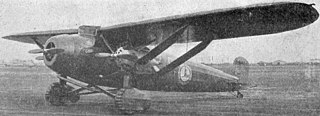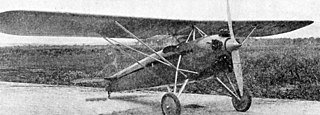Related Research Articles
The Shackleton-Murray SM.1 was a single-engined two-seat light aircraft designed in Britain and flying in 1933. It was a pusher driven parasol winged monoplane. Only one was built.

The Emsco B-2 Challenger was a US three-engined, six passenger aircraft flown in 1929. Only two were built and they were quite soon converted into two different Emsco types, one with one engine and the other with two.

The Aerial Engineering Corporation Standard 6W-3 was a commercial transport modification of the US Standard J-1 biplane military trainer aircraft, with new wings, engine and accommodation for four passengers. First flown in 1925, it was built in small numbers.

The Johnson Twin-60 was a small, two seat biplane intended for private owners. It had twin engines for safety and the performance and undercarriage designed for short and rough field use. Despite its refinements only one was definitely built
The Western Airplane King Bird, named after the tyrant flycatcher (Western) Kingbird, was a 1920s US civil transport accommodating three passengers in open cockpits. Only one was built.

The NAS Air King was a US light biplane transport aircraft designed in 1926 to carry three passengers in two open cockpits. Only one was built but in 1928 it was revised to carry two passengers and was more successful, with over twenty produced.
The Hess H-2 Blue Bird was a small US transport biplane, built in the 1920s and carrying two or four passengers according to engine power.

The 1927 Kirkham-Wiliams X or Kirkham-Williams Racer was designed as a private US contender for the 1927 Schneider Trophy. Though it flew just before the contest, it was still under development and was withdrawn. Soon after it was modified into a landplane, seeking to set a new speed record. Some high speed flights were made but no official record was set.
The Yackey Monoplane was an American three seat parasol monoplane flown in the late 1920s. Two prototypes had some success in the 1927 New York - Spokane National Air Derby and orders were placed but a crash killed its designer and ended production.

The Thunderbird W-14 was a small, three seat American passenger transport, first flown in 1926, entering production, significantly improved, in 1927 with several different engine options. About 40-50 were built before the financial collapse of the company in 1929.
The Stiles Dragon Fly was an American two seat monoplane aircraft of the late 1920s. It was aimed at private and club owners. Significant production was planned but few were built.
The Pacer Monoplane was a parasol wing, four seat, light aircraft, flown and produced in the US in the late 1920s.
The Simplex Red Arrow was a US single-engined monoplane produced in the late 1920s and early 1930s and intended as club machine or mail transport. Most used radial engines in the 90–110 hp (67–82 kW) range. They carried one or two passengers whose seats could be open or enclosed. One variant, the Red Arrow Dual Plane, was easily converted from monoplane to biplane and was available with two versions of the much more powerful Wright Whirlwind engines. In all about 20 were built.

The Miami Maid was a US three passenger amphibian first flown in 1929. Despite ambitious production plans, only two were built.

The Southern Air Boss was a 1920s U.S. biplane trainer aircraft. One prototype was built and by 1929 a new factory was ready for its production but this did not follow.

The Inland Sport series of parasol wing, sport and training side-by-side two seaters, introduced between 1928 and 1930, differed chiefly in their engines. They used three different radial engines, more than doubling the Sport's power over two years of development. 34 examples were built and frequently re-engined.

The Wallace Touroplane was a late 1920s U.S. three seat, high wing cabin monoplane. About 20 were built.

The Ireland Neptune was a four or five place pusher configuration biplane sold in flying boat and amphibian versions. Designed in the U.S. and first flown in 1927, well over 50 were built.

The Wiley Post Model A is a U.S. two seat sports biplane, built in small numbers in the 1930s.

The Huff-Daland HD.8A was a small civil transport biplane carrying two passengers built in the U.S. in 1922. The otherwise identical HD-9A offered an alternative engine.
References
- 1 2 3 4 5 6 "The Brown Monoplane". Aero Digest. 10 (3): 194. March 1927.
- 1 2 "Aerofiles" . Retrieved 7 February 2020.